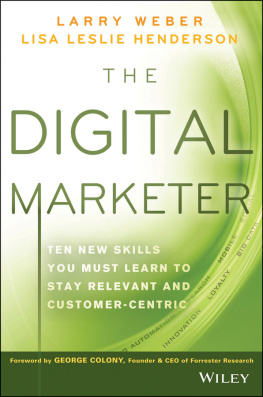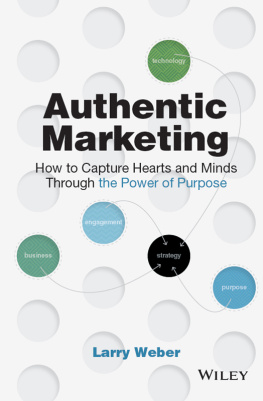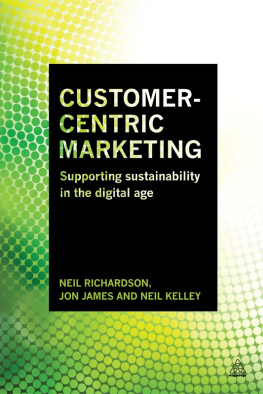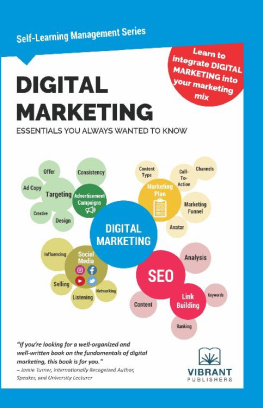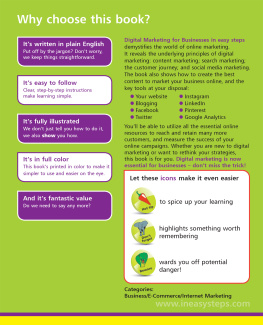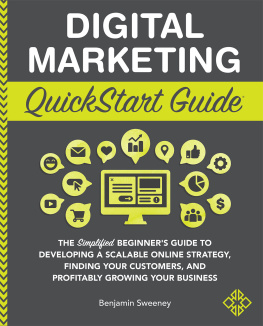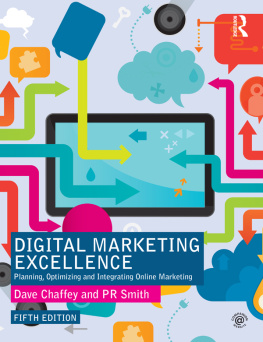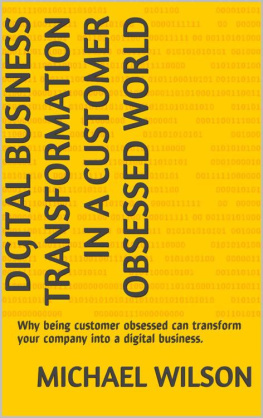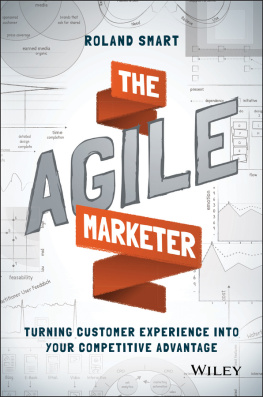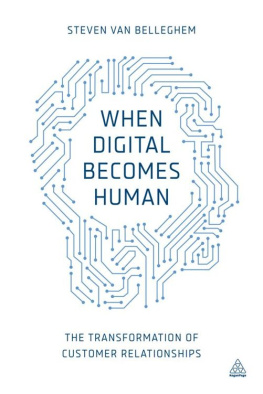
Cover image: iStockphoto / Atropat
Cover design: Wiley
Copyright 2014 by Larry Weber. All rights reserved.
Published by John Wiley & Sons, Inc., Hoboken, New Jersey.
Published simultaneously in Canada.
No part of this publication may be reproduced, stored in a retrieval system, or transmitted in any form or by any means, electronic, mechanical, photocopying, recording, scanning, or otherwise, except as permitted under Section 107 or 108 of the 1976 United States Copyright Act, without either the prior written permission of the Publisher, or authorization through payment of the appropriate per-copy fee to the Copyright Clearance Center, 222 Rosewood Drive, Danvers, MA 01923, (978) 7508400, fax (978) 6468600, or on the web at www.copyright.com. Requests to the Publisher for permission should be addressed to the Permissions Department, John Wiley & Sons, Inc., 111 River Street, Hoboken, NJ 07030, (201) 7486011, fax (201) 7486008, or online at www.wiley.com/go/permissions.
Limit of Liability/Disclaimer of Warranty: While the publisher and author have used their best efforts in preparing this book, they make no representations or warranties with respect to the accuracy or completeness of the contents of this book and specifically disclaim any implied warranties of merchantability or fitness for a particular purpose. No warranty may be created or extended by sales representatives or written sales materials. The advice and strategies contained herein may not be suitable for your situation. You should consult with a professional where appropriate. Neither the publisher nor the author shall be liable for damages arising herefrom.
For general information about our other products and services, please contact our Customer Care Department within the United States at (800) 7622974, outside the United States at (317) 5723993 or fax (317) 5724002.
Wiley publishes in a variety of print and electronic formats and by print-on-demand. Some material included with standard print versions of this book may not be included in e-books or in print-on-demand. If this book refers to media such as a CD or DVD that is not included in the version you purchased, you may download this material at http://booksupport.wiley.com. For more information about Wiley products, visit www.wiley.com.
ISBN 978-1-118-76083-3 (cloth); ISBN 978-1-118-76097-0 (ebk);
ISBN 978-1-118-76081-9 (ebk)
To our respective families, for their unwavering support and enthusiasm.
LW and LJLH
Acknowledgments
Writing a book evokes profound appreciation. Like jazz musicians that improvise on established compositions to create new melodies, we are grateful to the many who took the time to share their thoughts and experiences with us, further developing our initial observations into themes, and ultimately chapters. If there is music among these pages, it is due to their generosity.
Multiple business leaders, academics, and specialists contributed to the building of The Digital Marketer's melody and supportive harmonies. Mark Fuller (Rosc Global), Len Schlesinger (Harvard Business School), Sally Ourieff (Translational Consulting), Saul Kaplan (Business Innovation Factory), Rick Kash (Nielsen), Scott Epskamp (Leapfrog Online), Diane Hessan (Communispace), Scott Russell (Sparks Grove), Robin Frank (beep beep media), Dan Fukushima (Sparks Grove), Scott Neslin (Tuck School of Business), Peter Henderson (ShapeUp), Elizabeth Zaldastini Napier (Tuck School of Business), Josh McCall (Jack Morton Worldwide), Rodrigo Martinez (IDEO), B J Fogg (Stanford University), Becky Bermont (Creative Leadership), Alan Trefler (Pegasystems), Torrence Boone (Google), Debi Kleiman (MITX), Joi Ito (MIT Media Lab), J P Maheu (Bluefin Labs/Twitter), Wendy Murphy (Babson College), John Maeda (Rhode Island School of Design), Sanjay Dholakia (Marketo), R. Michael Hendrix (IDEO), Scott Ludwig (Skyword), Brian Babineau (Arnold Worldwide), and George Colony (Forrester Research) have all quite generously shared their time and insight.
We are, as always, indebted to Jill Kneerim, Larry's literary agent who heard the melody in this book, and for Richard Narramore, our editor at John Wiley & Sons, who enthusiastically agreed to publish it. Where would we be without Tiffany Coln, our editorial assistant at Wiley, who, like a metronome, kept us on task and on time, and Lauren Freestone, our production editor, who pulled multiple parts and myriad notes together into one score.
Producing a book takes a tremendous amount of planning and coordination. Heartfelt thanks to Nancy Provost, Larry's trusted executive assistant, and Ginger Ludwig for their orchestration of details, despite their already full agendas, and to Kevin Green at Racepoint Global for his keen insight and creativity that consistently breaks new ground.
Finally, a standing ovation to our respective families. We are always grateful for your accompaniment.
Foreword
PR professionals in the technology world are typically gentle, political animals, subtly and quietly steering their clients' offerings into the most flattering light. Then there is Larry Weber. I distinctly remember our first interaction when he brought a client to the old Forrester offices in Harvard Square. No subtlety. No calm nudging. No backroom whispering. It was an all-out, high-volume, lean-in, Fight Club, Oxford debatewith Larry passionately advocating for his client and deftly challenging the best arguments of the assembled know-it-all Forrester analysts. It was the first time that I had seen someone from the vendor PR world construct complex and compelling ideas about the future and how markets would transform. This guy was clearly an original thinker.
All of Larry's idea-centric passion and sense of the future shoot out of this volumeThe Digital Marketer. It's a book with impeccable timing. Why?
Because we are entering what Forrester calls the age of the customera 20-year business cycle in which the most successful enterprises will reinvent themselves to systematically understand and serve increasingly powerful customers. Customers will take power from institutions (especially companies) through their access to precise pricing, social voice, and ability to buy anything, from anywhere, from anyone, at any time.
The only way for companies to create a sustainable advantage in the future will be by constructing superior experiences that can win, retain, and serve the newly demanding customer.
And much of that experience will rest on digital. In the future, all companies will be software companies.
To stay relevant in the age of the customer, marketing leaders must be able to adapt toand exploitthe four market imperatives that are driving the rise of the empowered customer. They must be able to:
- Transform customer experiences. Companies must make substantive investments in customer experience to build relationships and amplify fans. In short, companies must transform to become customer-obsessed enterprises. Customer obsession focuses strategy, energy, and budget on processes that enhance knowledge of and engagement with customersand prioritizes them over maintaining traditional (and crumbling) competitive barriers. Marketing leaders must lead the customer-obsessed journey up, down, and across the company.
- Become digital disruptors. Digital has unleashed intense and rapid waves of innovation. Disruption requires agility that marketing isn't typically known for, with shorter development cycles and fewer organizational silos. Disruptors spread digital skills and a digital mind-set across strategy and operations, not just marketing or technology. To stand out, you must break your old patterns of doing business to make your customer's life easier. This won't be easypatterns of work and behavior are difficult to break.
Next page
